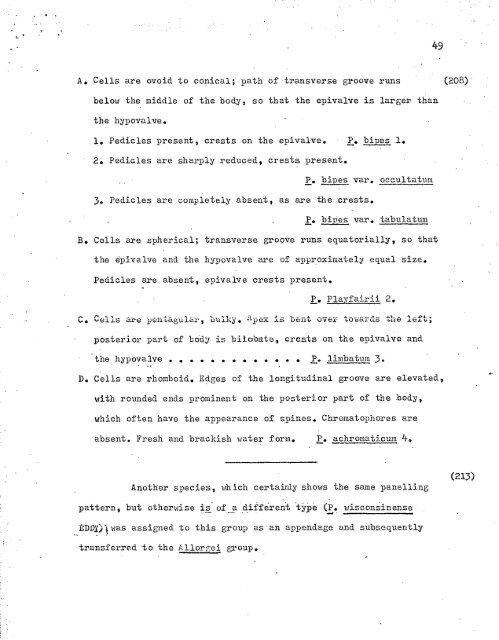Translation 2816
Translation 2816
Translation 2816
You also want an ePaper? Increase the reach of your titles
YUMPU automatically turns print PDFs into web optimized ePapers that Google loves.
49<br />
A. Cells are ovoid to conical; path of transverse groove runs<br />
below the middle of the body, so that the epivalve is larger than<br />
the hypovalve.<br />
1. •Pedicles present, crests on the epivalve. P. bipes 1.<br />
2. Pedicles are sharply reduced, crests present.<br />
P. bipes var. occultatum<br />
3. Pedicles are completely absent, as are the crests.<br />
P. bipes var. tabulatum<br />
B. Cells are spherical; transverse groove runs equatorially, so that<br />
the epivalve and the hypovalve are of approximately equal size.<br />
Pedicles are absent, epivalve crests present.<br />
P. Plavfairii 2.<br />
C. Cells are pentagular, bulky. Apex is bent over towards the left;<br />
posterior part of body is bilobate, crests on the epivalve and<br />
the hypovalve P limbatum 3.<br />
D. Cells are rhomboid. Edges of the longitudinal groove are elevated,<br />
with rounded ends prominent on the posterior part of the body,<br />
which often have the appearance of spines. Chromatophores are<br />
absent. Fresh and brackish water form. P. achromaticum 4.<br />
Another species, which certainly shows the same panelling<br />
pattern, but otherwise is of _a différent type (P. wisconsinense<br />
EDD;Wiwas assigned to this group as an appendage and subsequently<br />
transferred to the Allorr-ei group.
















